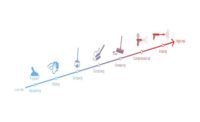Use, care & maintenance of cleaning tools

Despite the amount of soap and cleaning agents used on cleaning tools, they still need to be cleaned on their own and properly taken care of to ensure food safety and quality. Even if it seems like a brush that stays inside a soapy bucket all day should be clean, contaminants and microbes can still build up without the right maintenance.
Proper cleaning and maintenance begins with employee training and supervision and should be considered a significant part of the facility’s overall hygiene and sanitation plan.
The cleaning regime of different tools is influenced by their purpose or use. Different cleaning routines should be established for food contact and non-food contact tools. For example, a broom used in a low-risk environment probably won’t be cleaned after every use. However, a tank brush that’s used for cleaning the interior of a batch tank should be cleaned and sanitized before and after each use. To avoid cross-contamination, tools used on food contact surfaces must be easily identifiable and kept separate from those used on non-food contact surfaces. Color coding is often a simple solution for achieving this level of intended segregation.
To ensure tools have a longer utility and lifespan, they must be properly cared for. Cleaning your tools should be approached in the same manner that you clean any other equipment or surface in your facility.
- Dry clean. Remove visible and gross soils and debris.
- Pre-rinse. Rinse all areas and surfaces until they are visibly free of soil.
- Wash (soap and scrub). Use the right detergent in the right concentration with the right level of mechanical action in the right water temperature for the right contact time.
- Post-rinse. Rinse away all visible detergents and remaining soil.
- Inspect. Look again at crevices and other contamination traps to ensure they’re free of soils and detergents. Determine whether steps 1-4 should be performed again.
- Sanitize. Foam, wipe or spray sanitizing chemicals onto surfaces as per the appropriate instructions.
- Dry. Ensure adequate time is allotted for equipment to thoroughly dry.
- Verification. Gather proof that the cleaning performed achieved the expected level by following facility verification protocols.
As part of the care strategy, cleaning tools should be hung to thoroughly dry. Brushes, brooms and squeegees should be stored in wall brackets and shouldn’t touch the walls or other cleaning tools while drying or while being stored.
In addition to keeping tools clean, facilities should also move beyond the concept of just fixing or replacing a tool when it is broken. A tool that breaks while in use can trigger significant downtime and operational losses. Several companies have transitioned to the practice of diagnostic maintenance, where the maintenance crew sets a troubleshooting and monitoring schedule to ensure that tools and equipment are functioning as intended.
Preventive maintenance has become the hallmark of ensuring consistent tool effectiveness and efficiency over time through the appropriate scheduling and servicing of a facility’s cleaning products. Appropriate maintenance can also be combined with the 5S efficient workplace organization method, which involves sorting, setting-in-order, shining, standardizing and sustaining work tools. Solving problems before they affect food safety is the direction the food and beverage industry needs to head toward.
Proper use, care and maintenance of cleaning tools hangs on three primary considerations. First, there should be a validated protocol ensuring that the intended tasks are effective in decontaminating the tool. Second, care and maintenance must be regularly monitored by trained and competent personnel. Third, there must be a method of verifying cleaning effectiveness by another person through appropriate observation or tests.
Apart from color coding and workplace organization (5S), there is a great opportunity for the industry to look beyond maintenance by investing in hygienically designed tools. Indeed, the British Retail Consortium (BRC) Food Safety Standard, Issue 7, states “cleaning equipment shall be hygienically designed and fit for purpose.” There will be a need to employ effective and hygienically designed cleaning equipment to help maximize removal of contamination and food debris, minimize the risk of cross contamination and comply with audit requirements.
Looking for a reprint of this article?
From high-res PDFs to custom plaques, order your copy today!






